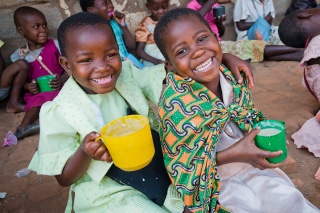
World Hunger Day 2023
What is the outlook for Zero Hunger?
The problems and injustices of the world can seem insurmountable and overwhelming at times. One of the most urgent injustices of our time is a lack of adequate food for all. Hunger shouldn’t be a problem in a world that produces enough for everyone.
However, despite this reality there are serious issues, like the fact that one-third of all food we produce goes to waste. There are many reasons for this, one of which is logistics, tragically resulting in food failing to reach many of the people who really need it. Like carrying valuables in a pocket riddled with holes, losses are inevitable until the gaps are mended.
The Sustainable Development Goals (SDG) – which world leaders pledged to meet by 2030 – include achieving Zero Hunger and the deadline is now a mere seven years away. This World Hunger Day, we ask: is a horizon of hope still visible for achieving Zero Hunger?
The bad news
Conditions haven’t been favourable in the last few years. In fact, according to the Global Hunger Index, progress seems to have halted lately:
The world is facing a serious setback in efforts to end hunger. Conflict, the climate crisis and the economic consequences of the COVID-19 pandemic – compounded by the war in Ukraine – are turning a crisis into a catastrophe.
The UN recently said:
150 million more people faced hunger in 2021 than in the previous year … 8% of the world’s population is projected to still face hunger in 2030, which is the same projection from 2015, the launch year for the SDG 2030 agenda.
Judging by this current trend, it’s a very steep climb to meet Zero Hunger goals by 2030 – in fact, according to the UN: “action to meet the goals is not yet advancing at the speed or scale required.”
The good news
On reaching a mountain summit, nothing compares to the feeling of looking down to see the vast distance covered on the way up.
We are certainly not at the top of the Zero Hunger mountain range – far from it. However, even with the current slow progress, there are many other peaks we can look out upon to remind ourselves of the astonishing fact that certain things our grandparents might have thought impossible are now a reality.
It is under-reported that we are in an era of rapid positive change, where we continue to have the potential to achieve important developments at an unforeseen rate.
HumanProgress.org shares some amazing statistics on changes that the world has seen since the end of World War II: For example.
In 1950, the average life expectancy at birth was only 48.5 years. In 2019, it was 72.8 years. That’s an increase of 50 percent … Between 1950 and 2018, the average income per person rose from $3,296 to $15,138. That’s an inflation adjusted increase of 359 percent.
Globally, massive progress has certainly been made. However, the poorest parts of the world are owed the same rate of change that the rest of the world has seen in recent years, and there are some very effective measures that can help achieve this.
School feeding is one such measure that can help with food security, and one which has great potential to address some of the issues that perpetuate hunger.
Mary’s Meals works with communities in 18 countries around the world to run school feeding programmes in areas where poverty and hunger are common barriers to education.

Mary’s Meals’ global programme relies heavily on community engagement and volunteer involvement, procures food locally wherever possible to stimulate local markets, and provides a social security net for parents whose circumstances mean they struggle to always provide a meal at home. This kind of programme can be scaled up effectively to meet the needs of thousands and even millions of hungry children at relatively low cost.
Responding collectively
Forecasts, figures, and analyses can show us current trends – but they can’t show us the inventive leaps that human beings are amazingly good at taking. There are ground-breaking innovations that will no doubt be made which will affect entire nations and continents – but there are also countless opportunities for small, daily acts of love that can also help to lift the burden of hunger from individuals.
We can all play a part. Because of our low-cost approach it only costs £19.15 to feed a child with Mary’s Meals for a whole school year. Praying or donating skills, goods or time is also a precious way to support. Let’s unite against hunger and continue knowing that despite inevitable setbacks, we have a very good reason to persist in this fight.
